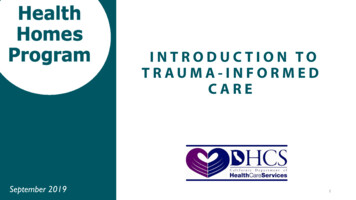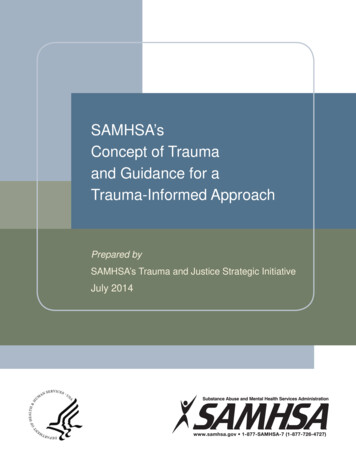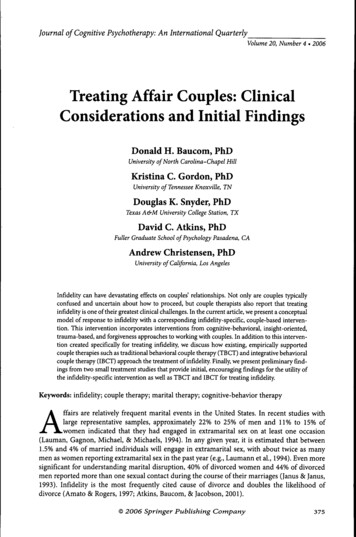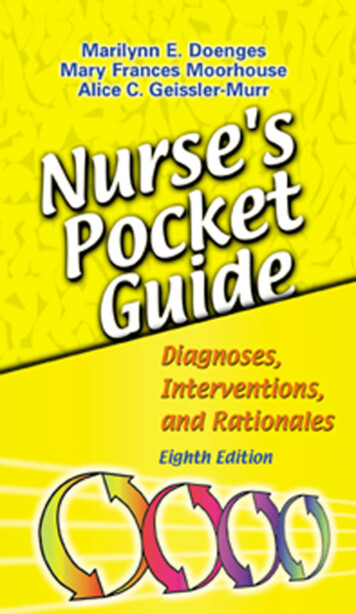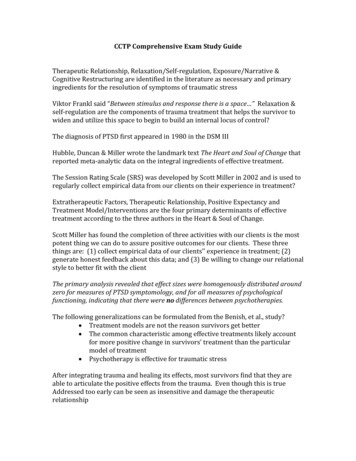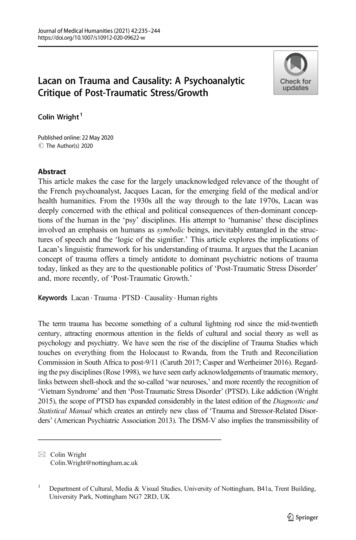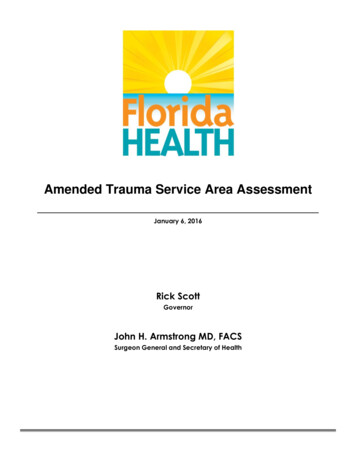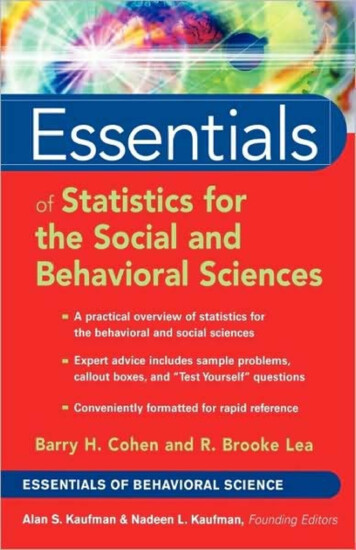
Transcription
Trauma-Informed Care inBehavioral Health ServicesTreatment Improvement Protocol (TIP) Series57Part 3: A Review of the LiteratureContents:Section 1—Literature ReviewSection 2—Annotated BibliographySection 3—General BibliographyU.S. DEPARTMENT OF HEALTH AND HUMAN SERVICESSubstance Abuse and Mental Health Services AdministrationCenter for Substance Abuse Treatment1 Choke Cherry RoadRockville, MD 20857
ContentsSection 1—A Review of the Literature . 1-1Introduction to Trauma and Traumatic Stress Reactions . 1-1Types of Trauma . 1-15Extent and Effects of Trauma and Traumatic Stress Reactions in Specific Populations. 1-24Responses to Trauma: Trauma and Behavioral Health. 1-38Screening and Assessing Trauma and Trauma-Specific Disorders . 1-65Prevention and Early Interventions for Traumatic Stress Reactions . 1-72Trauma-Specific Treatments . 1-79Integrated Approaches for Trauma and Substance Abuse . 1-93Other Integrated Approaches . 1-95Treating Complex Trauma/PTSD . 1-96Treatment for Specific Populations . 1-97Trauma-Informed Intervention Considerations . 1-102Building a Trauma-Informed Workforce . 1-105References . 1-108Appendix—Methodology . 1-153Section 2—Links to Select Abstracts. 2-1Section 3—General Bibliography . 3-1
Section 1—A Review of the LiteratureIntroduction to Trauma and Traumatic Stress ReactionsProviding a comprehensive literature review on trauma, traumatic stress, trauma-informed care(TIC), and trauma-related interventions is a daunting task when considering the quantity andprolific production of research in this area in the past 20 years. To manage the volume ofinformation, this literature review mainly focuses on reviews and meta-analyses rather thanseminal work to address many of the most relevant topics.What Is Trauma?In this text, “trauma” refers to experiences that cause intense physical and psychological stressreactions. “Trauma results from an event, series of events, or set of circumstances that isexperienced by an individual as physically or emotionally harmful or threatening and that haslasting adverse effects on the individual’s functioning and physical, social, emotional, or spiritualwell-being” (Substance Abuse and Mental Health Services Administration [SAMHSA], Traumaand Justice Strategic Initiative, 2012, p. 2). Although many individuals report a single specifictraumatic event, others, especially those seeking mental health or substance abuse services, havebeen exposed to multiple or chronic traumatic events. According to the Diagnostic and StatisticalManual of Mental Disorders, 5th Edition (DSM-5), trauma is defined as when an individualperson is exposed “to actual or threatened death, serious injury, or sexual violence” (AmericanPsychiatric Association [APA], 2013, p. 271).The definition of psychological trauma is not limited to diagnostic criteria, however. In fact,some clinicians have moved away from considering trauma-related symptoms as indicators of amental disorder and instead view them as part of the normal human survival instinct or as“adaptive mental processes involved in the assimilation and integration of new information withintense survival emphasis which exposure to the trauma has provided” (Turnbull, 1998, p. 88).These normal adaptive processes only become pathological if they are inhibited in some way(Turnbull, 1998), or if they are left unacknowledged and therefore untreated (Scott, 1990).Trauma has been characterized more broadly by others. For example, Horowitz (1989) defined itas a sudden and forceful event that overwhelms a person’s ability to respond to it, recognizingthat a trauma need not involve actual physical harm to oneself; an event can be traumatic if itcontradicts one’s worldview and overpowers one’s ability to cope.How Common Is Trauma?Trauma exposure is common in the United States. However, trauma exposure variesconsiderably according to different demographic characteristics and is especially high amongclients receiving behavioral health services (see the discussions under the headings “Extent andEffects of Trauma and Traumatic Stress Reactions in Specific Populations” and “Other DisordersThat May Be Related to Trauma ” for more information on relevant rates). Although the largesurveys discussed here provide data on trauma exposure for the general population, publishedTrauma-Informed Care in Behavioral Health Services1-1
literature often provides more specific data as well, which is one reason why differences inexposure according to gender and race/ethnicity are highlighted here.At one time, trauma was considered an abnormal experience. Contrary to this myth, the firstNational Comorbidity Study (NCS), a large national survey designed to study the prevalence andeffects of mental disorders in the United States, established how prevalent traumas are in thelives of the general U.S. population (Kessler, Sonnega, Bromet, Hughes, & Nelson, 1995).Presented with a list of 11 types of traumatic experiences and a 12th “other” category, 60.7percent of men and 51.2 percent of women reported experiencing at least one trauma in theirlifetime (Kessler, 2000; Kessler et al. 1995; 1999): The most common trauma was witnessing someone being badly injured or killed (cited by35.6 percent of men and 14.5 percent of women).The second most common trauma was being involved in a fire, flood, or other naturaldisaster (cited by 18.9 percent of men and 15.2 percent of women).The third most common trauma was a life-threatening accident/assault, such as from anautomobile accident, a gunshot, or a fall (cited by 25 percent of men and 13.8 percent ofwomen.The NCS also found that it was not uncommon for individuals to have experienced multipletraumatic events (Kessler, 2000). Among men in the total sample, 14.5 percent reported twotraumatic events, 9.5 percent reported three, 10.2 percent reported four or more, and 26.5 percentreported only one such event. Among women, 13.5 percent of the total sample reported twotraumatic events, 5 percent reported three, 6.4 percent reported four or more, and 26.3 percentreported only one.The National Epidemiologic Survey on Alcohol and Related Conditions (NESARC) is anotherlarge national survey of behavioral health, but it only assessed posttraumatic stress disorder(PTSD) and trauma exposure in its second wave of interviews, in which 34,653 of the original43,093 respondents were reinterviewed (Pietrzak, Goldstein, Southwick, & Grant, 2011a). In theWave 2 interview, respondents were asked about 27 different types of potentially traumaticevents; the most commonly reported traumatic events were serious illness or injury to someoneclose (affecting 48.4 percent of those who did not have PTSD symptoms and 66.6 percent ofthose with PTSD), unexpected death of someone close (affecting 42.2 percent of those withoutPTSD and 65.9 percent of those with PTSD), and seeing someone badly injured or killed(affecting 24 percent of those without PTSD and 43.1 percent of those with PTSD; Pietrzak,Goldstein, Southwick, & Grant, 2011a). According to the same data, 71.6 percent of the samplewitnessed trauma, 30.7 percent experienced a trauma that resulted in injury, and 17.3 percentexperienced a trauma that was purely psychological in nature (e.g., being threatened with aweapon; El-Gabalawy, 2011).NESARC also found that exposure to specific traumatic events varied considerably according torace, ethnicity, or cultural group. The survey found that 83.7 percent of non-Latino WhiteAmericans reported a traumatic event, compared with 76.4 percent of African Americans, 68.2percent of Latinos, and 66.4 of percent of Asian Americans, Native Hawaiians, or PacificIslanders (Roberts, Gilman, Breslau, Breslau, & Koenen, 2011). Exposure to specific traumasalso varied considerably. White Americans were more likely to report an unexpected death of1-2Part 3, Section 1—A Review of the Literature
someone they knew (44.7 percent did) than were African Americans (39.9 percent), Latinos(29.6 percent), and Asian Americans, Native Hawaiians, or Pacific Islanders (25.8 percent) aswell as being more likely to report having a close friend/relative who experienced a lifethreatening injury. On the other hand, African Americans were the most likely to report being thevictim of assaultive violence (29.7 percent), followed by White Americans (26.1 percent),Latinos (25.6 percent), and Asian Americans, Native Hawaiians, or Pacific Islanders (16.3percent). In terms of combat trauma, White Americans and African Americans were about aslikely to have been combatants (10 percent of each group reported combat trauma), and morelikely than Asian Americans, Native Hawaiians, or Pacific Islanders (5.4 percent) or Latinos (4.4percent). However, Asian Americans, Native Hawaiians, or Pacific Islanders were the mostlikely to have been unarmed civilians in a war zone (7.5 percent), followed by Latinos (3.8percent), White Americans (2 percent), and African Americans (1.9 percent).Across the world, according to data from the World Health Organization (WHO) surveys, whichincludes the NCS and NCS replication (NCS-R) and surveys from 20 other countries, the mostcommonly reported traumas are the death of a loved one (30.5 percent), witnessing violence toothers (21.8 percent), and experiencing interpersonal violence (18.8 percent; Stein et al., 2010).As Kessler (2000) noted, trauma from assaultive violence in the United States is likely to bemore common than in most other developed countries in general. However, trauma related toother traumatic events (e.g., automobile accidents, natural disasters) appear to be quite similarthroughout developed countries.A longitudinal survey from New Zealand also provides useful data on trauma exposure. In thissurvey, a cohort of subjects from a single town was interviewed at age 26 and again at age 32 inorder to evaluate what constituted the worst trauma those individuals had experienced (Koenen,Moffitt et al., 2008). The types of worst experiences reported before age 26 were: Sudden unexpected death by trauma of a close family member or friend (38 percent).Personal assault or victimization (32 percent).Serious accidents (14 percent).Hearing about or witnessing a close friend or relative experiencing an assault, seriousaccident, or serious injury (12 percent).Personal illness (3 percent).Natural disaster (1 percent)How Common Are Traumatic Stress Reactions?As with trauma rates, PTSD rates vary considerably across different demographic groups. Thereader should consult the section titled “Extent and Effects of Trauma and Traumatic StressReactions in Specific Populations” for more specific information on PTSD rates. More generalinformation from major surveys is included in this section.The DSM-5 (APA, 2013) estimates that the prevalence rate of PTSD in the U.S. adult populationis about 8 percent, but studies of populations at high risk for PTSD (e.g., combat veterans,survivors of natural disasters) have found PTSD rates ranging from 3 to 58 percent. The NCS(which evaluated behavioral health disorders, including PTSD) found that, for Americans ages15 to 54, the lifetime prevalence of PTSD (based on DSM Third Edition, text revision [DSM-IIITrauma-Informed Care in Behavioral Health Services1-3
R; APA, 1987] criteria) was 7.8 percent, with women more than twice as likely as men to havethe disorder during their lives (10.4 percent of women and 5 percent of men; Kessler et al.,1995). In the NCS-R, which interviewed 9,282 individuals ages 18 and older between February2001 and April 2003, the lifetime prevalence of PTSD was 6.8 percent, again with a much higherrate for women (9.7 percent) than for men (3.6 percent; Kessler, Berglund et al., 2005; NCS,2005). The past-year prevalence rate for PTSD was 3.5 percent, with 5.2 percent of women and1.8 percent of men having PTSD in the 12 months prior to their interviews (Kessler, Chiu et al.,2005).Kessler, Berglund et al. (2005) examined the issue of lifetime prevalence in the NCS-R todetermine whether the prevalence statistics of the NCS were still valid in light of changes to thediagnostic criteria that occurred with the publication of the DSM Fourth Edition, text revision(DSM-IV-TR; APA, 2000). The study was divided into two parts. Part I included face-to-facediagnostic interviews of 9,282 participants who were 18 years of age or older. Part II includedfactors related to diagnosis (e.g., risk factors) and was completed only with participants fromPart I who had a “lifetime disorder” and a probability sample from other Part I participants(n 5,692). Data analysis in this study estimated a lifetime PTSD prevalence of 6.8 percent, butthe authors also analyzed the data to determine projected lifetime risk and found that at age 75,the lifetime risk for PTSD was 28 percent higher than the lifetime prevalence estimate. However,the authors suggested that because of certain study limitations (e.g., related to sampleparameters, reluctance to participate or to disclose diagnoses), these results should be considereda conservative estimate.As noted earlier, Wave 1 of NESARC did not evaluate PTSD, but Wave 2 found that 6.4 percentof the population (8.6 percent of women and 4.1 percent of men) had PTSD at some point duringtheir lives (Pietrzak et al., 2011a). NESARC researchers also evaluated lifetime prevalence ofpartial PTSD (defined as including at least one symptom under Criteria B, C, and D, withsymptom duration of at least 1 month) and found that 6.6 percent of the total population (8.6percent of women and 4.5 percent of men) met criteria for partial but not full PTSD at somepoint during their lives. It should be noted, however, that most large behavioral health surveys,such as the NCS and NESARC, rely on retrospective evaluation of symptoms, and some researchindicates that they underestimate behavioral health disorders compared with prospectivelongitudinal studies (Moffitt et al., 2009). Differences in prevalence estimates may also berelated both to changes in PTSD diagnostic criteria and to a variety of methodologicaldifferences in the research (e.g., different diagnostic instruments, procedures) on which theseestimates were based (Kessler, 2000; Kessler, Chiu et al., 2005; Kessler et al., 1995; Narrow,Rae, Robins, & Regier, 2002).It is also worth noting that delayed PTSD may account for a considerable percentage of PTSDcases. A meta-analytic review that included studies in which individuals were assessed 1 to 6months after trauma exposure and again at least 6 months later found that 24.8 percent of PTSDcases involved delayed trauma (Smid, Mooren, van der Mast, Gersons, & Kleber, 2009). Studiesincluded in the review found between 3.8 and 83.3 percent of their samples had delayed PTSD.Factors that were associated with significantly greater odds of having delayed rather thannondelayed PTSD included a Western (as opposed to non-Western) cultural background andmilitary combat exposure.1-4Part 3, Section 1—A Review of the Literature
More recently, Smid, van der Velden, Gersons, and Kleber (2012) conducted a study of 1,083individuals affected by a large fireworks disaster to evaluate delayed PTSD rates at both 18months and 4 years after the disaster. In their review of prospective studies of disaster survivors,they found that between 2 and 19 percent of survivors developed delayed PTSD, whereas in theirown study, 3.8 percent (n 24) of the total sample (n 636) who were available for all assessmentshad delayed PTSD and 13.5 percent had PTSD that was not delayed.What Is Complex Trauma?An individual has been exposed to complex trauma when he or she has either experiencedrepeated instances of the same type of trauma over a period of time or experienced multiple typesof trauma (van der Kolk, McFarlane, & Weisaeth, 1996). Expert consensus is that people whohave complex trauma will typically require more intensive and extensive treatment as well aspossible adaptations to standard treatment (see the expert clinician survey in Cloitre et al., 2011).This Treatment Improvement Protocol (TIP) uses a definition of complex trauma developed bythe National Child Traumatic Stress Network (NCTSN; 2003), which defines complex trauma asa “dual problem” involving both “exposure to traumatic events and the impact of this exposureon immediate and long-term outcomes” (p. 5). NCTSN notes that complex trauma usuallyinvolves multiple instances of trauma (occurring either simultaneously or sequentially) andmultiple forms of trauma (e.g., experiencing emotional abuse, sexual abuse, and physical abuse).Also, complex trauma, such as that experienced by children who sustain repeated abuse,typically results in emotional dysregulation and a lack of appropriate coping mechanisms, whichin turn can increase the risk of further traumatic experiences. Although the NCTSN definitionwas developed for explaining childhood trauma, it can be adapted to fit an adult population.Herman (1992) was among the first to highlight the inadequacy of existing diagnostic criteria forPTSD for people who have complex trauma by pointing out that these criteria were developedbased on a clinical consideration of symptoms experienced by individuals who had survivedrelatively time-limited traumatic experiences (e.g., combat veterans, survivors of rape). Hermanproposed that many individuals with a history of prolonged and repeated trauma (as opposed totrauma that is time-limited or related to a single traumatic event) present with clinicalcharacteristics that “transcend simple PTSD” (p. 379); these characteristics include physicalsymptoms (including many of the symptoms listed in the diagnostic criteria for PTSD, althoughthey may appear more “complex, diffuse, and tenacious” [p. 379]), personality changes in whichthe individual’s sense of identity is negatively affected and which may inhibit the individual’sability to form relationships with others, and a propensity for vulnerability to further harm (byself or others).In 1992, Herman published the seminal work Trauma and Recovery (revised in 1997), whichdiscussed proposed changes to the next DSM that would include a new term for this traumarelated constellation of symptoms. Her suggestion was the term “complex post-traumatic stressdisorder” (complex PTSD). However, none of the proposed changes she discussed were includedin the DSM-IV (APA, 1994), DSM-IV-TR (APA, 2000), or DSM-5 (APA, 2013). Jackson,Nissenson, and Cloitre (2010) observed that the DSM-IV classification of “associated featuresand disorders” (APA, 2000) for PTSD is intended to cover symptoms of complex PTSD (e.g.,problems with affect regulation, impaired relationships), but it does not take into account one keyaspect of complex PTSD as it was originally defined, which is that such symptoms and disordersTrauma-Informed Care in Behavioral Health Services1-5
(e.g., substance abuse) are not viewed as secondary to PTSD symptoms, but rather, as equallyimportant and directly related to traumatic experiences.Complex trauma is typically interpersonal and generally involves situations in which the personwho is traumatized cannot escape from the traumatic experiences because he or she isconstrained physically, socially, or psychologically (Herman, 1992). Because of this, people whohave experienced complex trauma often have additional disturbances in their ability to selfregulate—beyond those seen in PTSD—that are not related to complex trauma. These includedifficulties in emotional regulation, difficulties in one’s capacity for relationships, problems withattention or consciousness (e.g., dissociative experiences), a disturbed belief system, and/orsomatic complaints or disorganization (Briere & Scott, 2012; Cloitre et al., 2011; van der Kolk,McFarlane, & Van der Hart, 1996).What Is Acute Stress Disorder?Acute stress disorder (ASD), according to the DSM-5, involves a traumatic stress reaction thatoccurs within 1 month of trauma exposure and includes at least nine symptoms from any of thefive categories (intrusion, negative mood, dissociation, avoidance, and arousal; APA, 2013). Toreceive this diagnosis, the individual also has to display a reaction that causes significant distressor impairment in social, occupational, or other important areas of functioning. ASD can occur atthe time of the trauma exposure or any time within 4 weeks of that event As Roberts, Kitchiner,Kendardy, and Bisson (2010) observed, there is a large degree of overlap between ASD andPTSD symptoms, but what distinguishes them is the timing of those symptoms relative to traumaexposure. Cardeña and Carlson (2011) provided a history of the ASD diagnosis and discussedthe validity of the diagnostic criteria. ASD can develop into PTSD if the symptoms extendbeyond 1 month.What Is PTSD?PTSD is a traumatic stress reaction that develops in response to a significant trauma. It is amental disorder, and for behavioral health providers in the United States, the currently accepteddiagnostic criteria for the disorder are those provided by the DSM-5 (APA, 2013). Forprofessionals in the field of behavioral health, the definition of psychological trauma ishistorically and clinically tied to the diagnostic criteria for PTSD, which made their firstappearance in the DSM-III (APA, 1980). However, over the years, the diagnostic criteria haveundergone some significant changes. These changes are important factors to consider whenreading, evaluating, and especially comparing research.Criterion A concerns the type of trauma involved; Criterion B describes symptoms of intrusion;Criterion C includes the presence of persistent avoidance of stimuli associated with the trauma;Criterion D highlights symptoms of negative alterations in cognitions and mood associated withthe traumatic event(s); Criterion E includes marked alterations in arousal and reactivity as itrelates to the trauma; Criterion F addresses the duration of the symptoms; and Criterion Gincludes clinical distress or impairment in important areas of functioning (e.g., occupational).The presenting symptoms cannot be attributable to the physiological effects of a substance,including alcohol or medications.1-6Part 3, Section 1—A Review of the Literature
The first part of the evolving PTSD definition is Criterion A (Exhibit L-1), which describeschanges in the definition of a traumatic event from that of “a recognizable stressor,” to “an eventthat is outside the range of usual human experience,” to an event that is defined by two specificdescriptors, to “exposure to actual or threatened death, serious injury, or sexual violence.”Exhibit L-1Evolution of Criterion A for PTSD in the DSMDSM-III (1980)“Existence ofarecognizablestressor thatwould evokesignificantsymptoms ofdistress inalmosteveryone”(APA, 1980,p. 238).DSM-III-R (1987)“The person hasexperienced an eventthat is outside therange of usualhuman experience[emphasis added] andthat would bemarkedly distressingto almost anyone”(APA, 1987, p. 250;examples giveninclude serious threator harm to self orothers).DSM-IV (1994) & DSM-IV-TR(2000)“The person has been exposedto a traumatic event in whichboth of the following werepresent [emphasis added]:DSM-5 (2013)“Exposure to actualor threatened death,serious injury, orsexual violence”(APA, 2013, p. 271).(1) the person experienced,There are four wayswitnessed, or was confrontedthat an individual canwith an event or events thatexperience theinvolved actual or threatenedtraumatic event(s):death or serious injury, or adirectly, witnessingthreat to the physical integrity of the event, learningself or others.about the event, orthrough repeated or(2) the person’s responseextreme exposure toinvolved intense fear,aversive details of thehelplessness or horror” (APA,1994, pp. 427–428; APA, 2000, traumatic event(s).pp. 467–468).Criterion B has also evolved. In the DSM-III (APA, 1980), it described reexperiencing a traumathrough three symptoms: intrusive thoughts, recurrent dreams, or the feeling of reexperiencingthe trauma as a result of some sort of stimulus. DSM-III-R (APA, 1987) expanded Criterion B byadding another symptom: “intense psychological distress at exposure to events that symbolize orresemble an aspect of the traumatic event, including anniversaries of the trauma” (p. 250). It alsoadded information regarding symptom presentations that may occur in children (e.g., repetitiveplay expressing aspects of the trauma). DSM-IV (APA, 1994) added a fifth symptom of“physiological reactivity on exposure to internal or external cues that symbolize or resemble anaspect of the traumatic event” (p. 428) and additional symptom presentations that may occur inchildren (e.g., nightmares that lack recognizable features, reenactments of the trauma). Likewise,DSM-5 (2013) became more developmentally focused in diagnostic criteria and added a separatecriterion for children younger than 7 years of age. Additional changes in the DSM-5 include amore explicit definition of the stressor criterion, an additional and separate symptom clusterhighlighting avoidance and persistent negative alterations in cognitions and mood, and theelimination of an individual’s subjective reaction to the traumatic event (intense fear,helplessness, or horror).Criterion C addresses avoidance of stimuli associated with the traumatic event(s). Criterion Cevolved between DSM-III and DSM-III-R (Exhibit L-2), with only minimal changes in languageTrauma-Informed Care in Behavioral Health Services1-7
in the DSM-IV and DSM-IV-TR (APA, 1994; 2000). The DSM-5 dropped the terminology ofnumbing of general responsiveness in this criterion’s heading (APA, 2013).Exhibit L-2Evolution of Criterion C for PTSD in the DSMDSM-III (1980)DSM-III-R (1987)DSM-5 (2013)“Numbing ofresponsiveness toor reducedinvolvement with theexternal world,beginning sometimeafter the trauma, asshown by at leastone of the following:“Persistent avoidance of stimuli associatedwith the trauma or numbing of generalresponsiveness (not present before thetrauma), as indicated by at least three of thefollowing:“Persistent avoidance ofstimuli associated with thetraumatic (event(s),beginning after thetraumatic event(s)occurred, as evidenced byone or both of thefollowing:(1) markedlydiminished interestin one or moresignificant activities(2) feeling ofdetachment orestrangement fromothers(3) constrictedaffect” (APA, 1980,p. 238).(1) efforts to avoid thoughts or feelingsassociated with the trauma(2) efforts to avoid activities or situationsthat arouse recollections of the trauma(3) inability to recall an important aspect ofthe trauma (psychogenic amnesia)(4) markedly diminished interest insignificant activities (in young children, lossof recently acquired developmental skillssuch as toilet training or language skills)(5) feeling of detachment or estrangementfrom others(6) restricted range of affect, e.g., unable tohave loving feelings(7) sense of a foreshortened future, e.g.,does not expect to have a career, marriage,or children, or a long life” (APA, 1987, p.250).(1) Avoidance of or effortsto avoid distressingmemories, thoughts, orfeelings about or closelyassociated with thetraumatic event(s).(2) Avoidance of or effortsto avoid externalreminders ( people,places, conversations,activities, objects,situations) that arousedistressing memories,thoughts, or feelingsabout or closelyassociated with thetraumatic event(s)” (APA,2013, p. 272).Criterion D addresses symptoms related to negative alterations in cognitions and moodassociated with the traumatic event(s). This symptom cluster is a new addition to DSM-5 andincludes “irritable behavior and angry outbursts (with little or no provocation), typicallyexpressed as verbal or physical aggression toward people or objects; reckless or self-destructivebehavior; hypervigilance; exaggerated startle response; problems with concentration; sleepdisturbance (e.g., difficulty falling or staying asleep or restless sleep)” (APA, 2013, p. 272). Inprior DSM publications, criterion D related to increased arousal (e.g., difficulties with sleep andconcentration). In DSM-5, this criterion has moved to Criterion E, with no other changes insymptoms. This criterion has also evolved from the description in the DSM-III to a more concisedescription in the DSM-III-R, and it has become even more concise in the DSM-IV, DSM-IVTR, and DSM-5 (Exhibit L-3).1-8Part 3, Section 1—A Review of the Literature
Exhibit L-3Evolution of Criterion E for PTSD in the DSMDSM-III (1980)DSM-III-R (1987)“At least two of the followingsymptoms that were not presentbefore the trauma:“Persistent symptoms ofincreased arousal (not presentbefore the trauma), as(1) hyperalertness orexaggerated startle responseindicated
Section 1—A Review of the Literature Introduction to Trauma and Traumatic Stress Reactions Providing a comprehensive literature review on trauma, traumatic stress, trauma-informed care (TIC), and trauma-related interventions is a daunting task when considering the quantity and prolific
